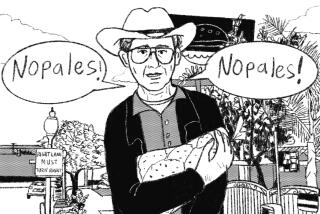Mexico’s Alejandro Santiago evokes the toll of immigration with clay figures

Watch out, there’s one sneaking up right behind you: stubby brown body, big googly eyes, quizzical expression plastered onto the flat, ceramic face.
And over there, against the wall, a cluster of five, 10, 20 fellow beings, plus who knows how many more still to come? Elbowing their way into your consciousness, encroaching on your personal space -- or perhaps it is we who are intruding on them.
Looking a bit like C-3PO’s long-lost pre-Columbian ancestors, the almost-human creatures are everywhere as you stroll through the white-walled galleries of the Museo de Arte Contemporaneo in this stylish colonial city six hours south of the Mexican capital. The work in progress, “2501 Migrantes” (2501 Migrants) by local painter and sculptor Alejandro Santiago, represents one artist’s obsessive attempt to grapple with the human and social toll of mass immigration.
That theme runs deep in Oaxaca state, a poor, mainly rural region heavily populated by Indians, that over the years has lost large numbers of desperate farmers and low-skill laborers who’ve gone to work in Mexico City, the United States and elsewhere. Since it opened at the end of February, Santiago’s installation has drawn more than 7,000 visitors.
And though the show’s title is a bit of a misnomer -- only about 380 of Santiago’s clay figures are on display here -- that’s surely enough of a crowd to start a passionate debate on what in recent weeks has become a divisive topic on both sides of the border.
Yet Santiago believes that his large-scale, labor-intensive work, which is on view through May 8, can steer clear of the type of facile arguments being batted around by politicians and blowhard commentators. “Right now, important things have occurred on this subject, a subject that is very powerful,” says the 42-year-old. “My theme doesn’t embrace much in the way of solutions. It only makes a call to the people. It offers a little reflection, in order to propose some other good alternatives.”Aside from Iraq, few current issues split Americans more than immigration policy. The halls of Congress and radio airwaves crackle with angry diatribes on the subject. Last month, hundreds of thousands of native and immigrant Latin Americans, most of Mexican origin, took to the streets in Los Angeles and other cities to protest proposed federal legislation that could classify illegal immigrants as felons and prompt mass deportations.
Santiago’s own views on immigration are multifaceted, and he says he wanted to avoid making “2501 Migrantes” into a polemical piece. But the theme is close to his personal history, and his heart. Like scores of other Mexican and Central American towns, Santiago’s native village of Teococuilco de Marcos Perez, in a remote mountain area of Oaxaca state, has lost about half of its population to emigration in recent decades.
At present, Santiago has completed about 500 of the sculptures for “2501 Migrantes.” When the work is complete, he intends to take all 2,501 of his homely, strangely poignant figures to Teococuilco and “repopulate” the decimated village by placing the sculptures on the patio of each house and in the local church, municipal square and other public places. He hopes to finish all the sculptures by November of this year.
“It’s a theme that has obsessed Alejandro,” says Femaria Abad, director of the Museo de Arte Contemporaneo, which is hosting the work’s first museum outing. “With this work, in a way, he is summoning the absent ones.”
At the spare, pristine Oaxaca museum, the “migrants” confront you in stairwells and startle you as you come upon them huddled in claustrophobic corners of the galleries. A number of the figures have elaborate markings, like tattoos, on their bodies. A few bear boot prints on their backsides. Most are about three-quarters the size of a typical adult, others no bigger than a child.
Mutely expressive, they communicate through body language and facial contortions. In a side courtyard on the ground floor of the two-story museum, some lie stretched out in crude wooden coffins. Another room chillingly displays a pile of sculpted “body” parts -- arms, legs, torsos.
Whether alone or packed into loose scrums of three, four or a dozen or more, Santiago’s figures dance on a thin line between individuality and anonymity, the autonomous subject versus the statistical mass. The closer you look, the more singular each appears. “They overflow their condition of stone and transmit their humanity,” says museum director Abad.
Santiago himself has lived the immigrant life. Though he was born in Teococuilco, he left at age 9 when his parents moved to Oaxaca city, the culturally rich, ethnically diverse state capital. Later, he went on to study at the Centro de Educacion Artistica in Oaxaca, and subsequently trained at the prestigious Taller de Artes Plasticas Rufino Tamayo, named for the celebrated Oaxacan painter and muralist. Tamayo, a Zapotec Indian, is one of the founding fathers of Mexican Modernism, along with Diego Rivera, David Alfaro Siqueiros and Jose Clemente Orozco.
When Santiago returned to Teococuilco years later, the village of his youth was largely gone. Today, he has numerous relatives and friends living on the other side of the border, including some in the Los Angeles area, home to one of America’s largest Oaxacan emigre communities.
To gain a better understanding of what Mexican illegal migrants go through, Santiago in October 2002 flew to Tijuana and hired a “coyote,” or human smuggler, to help him cross the border, a harrowing experience. “It’s an incredible sensation, a sensation of many words, of fear, terror, anxiety, your heart palpitates,” he says. This feeling of physical and psychological vulnerability inspired him to render the “Migrantes” figures utterly naked. Santiago also has visited the United States legally many times.
Santiago still makes his home in Oaxaca, where he operates a ranch-workshop about 45 minutes outside the state capital. Like a number of young contemporary artists, he is drawn to the region’s cultural treasures and its rhapsodic, high-desert landscapes.
“I also love very much the light of Oaxaca,” Santiago says. “I have traveled to many places, and I believe that it has a personality, the light of Oaxaca. Perhaps it’s the tropical influence. It’s a very special color.”
A friendly man with a soft, unhurried voice and an expansive laugh, Santiago says that he first conceived the idea of the “2501 Migrantes” project while living and studying art in Paris in 1998. During his European sojourn he haunted many art centers and galleries, soaking up the Modernist influences of artists such as Picasso and, to judge from his work, the Swiss painter-sculptor Alberto Giacometti.
The figures in “2501 Migrantes” also bring to mind the imperial terra cotta warriors unearthed from the tomb of the Chinese ruler Qin Shi Huang Di, builder of the Great Wall, as well as the rows of colossal heads on Easter Island and the various stone gods and demigods left by the great pre-Columbian empires of Latin America.
However, when Santiago sets to work on one of the handmade figures, he says he’s not thinking of any particular artistic antecedent. “I think I have seen a lot, and from all this I try to make each piece have its own image, its personality,” he says.
Although Santiago’s clay wanderers can provoke strong emotions, their creator takes a more circumspect view of the larger immigration debate, which he calls a “global” issue. Solving the problems of immigration, he says, will require “a historical revision” both outside and within Mexico, to foster new forms of employment so that fewer people will be tempted to flee the country in search of a better life.
One option, he suggests, is to promote more development of Mexico’s natural and human resources and unique cultural assets.
“I know towns around the city of Oaxaca that have not experienced the phenomenon of immigration,” he says, citing the world-famous rug-weaving village of Teotitlan del Valle, whose Indian community is among the state’s most prosperous.
“Incredible village, incredible village,” Santiago says. “They conserve their dialogue, they conserve their native attire, with pride, they all speak English, they all speak French, they all travel around the world to get prizes! They are like exemplary figures.”
To similar ends, Santiago has recruited a number of young people to help him make the “Migrantes” sculptures, most of them the children of poor local farmers.
“I have many students in my house,” says Santiago, who is married and has two children. “It’s a madhouse, really.”
At one point earlier during the project, he says, he determined that the young workers were having trouble concentrating because they’d been removed from the daily rhythms of farm life.
So he bought a number of farm animals -- ducks, horses, a burro -- and brought them to the ranch to help his young hired hands feel more at home.
He also has initiated a water-conservation system, an alfalfa-growing project and other measures to help the workers develop “a self-sufficient ecosystem that doesn’t need money.” It is the loss of connection “with their land, their people, their environment” that causes many people worldwide to emigrate in the first place, he says.
In the months ahead Santiago hopes that “2501 Migrantes” may be able to migrate to museums and cultural spaces in other parts of Mexico, along the border and possibly the United States, though no arrangements have yet been made.
And he’s hoping to travel to the West Coast of the U.S. soon to visit friends and family -- if his visa papers come through. “Los Angeles,” he says dreamily. “That’s where I want to go.”
More to Read
Start your day right
Sign up for Essential California for news, features and recommendations from the L.A. Times and beyond in your inbox six days a week.
You may occasionally receive promotional content from the Los Angeles Times.







